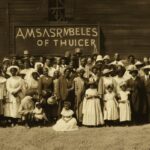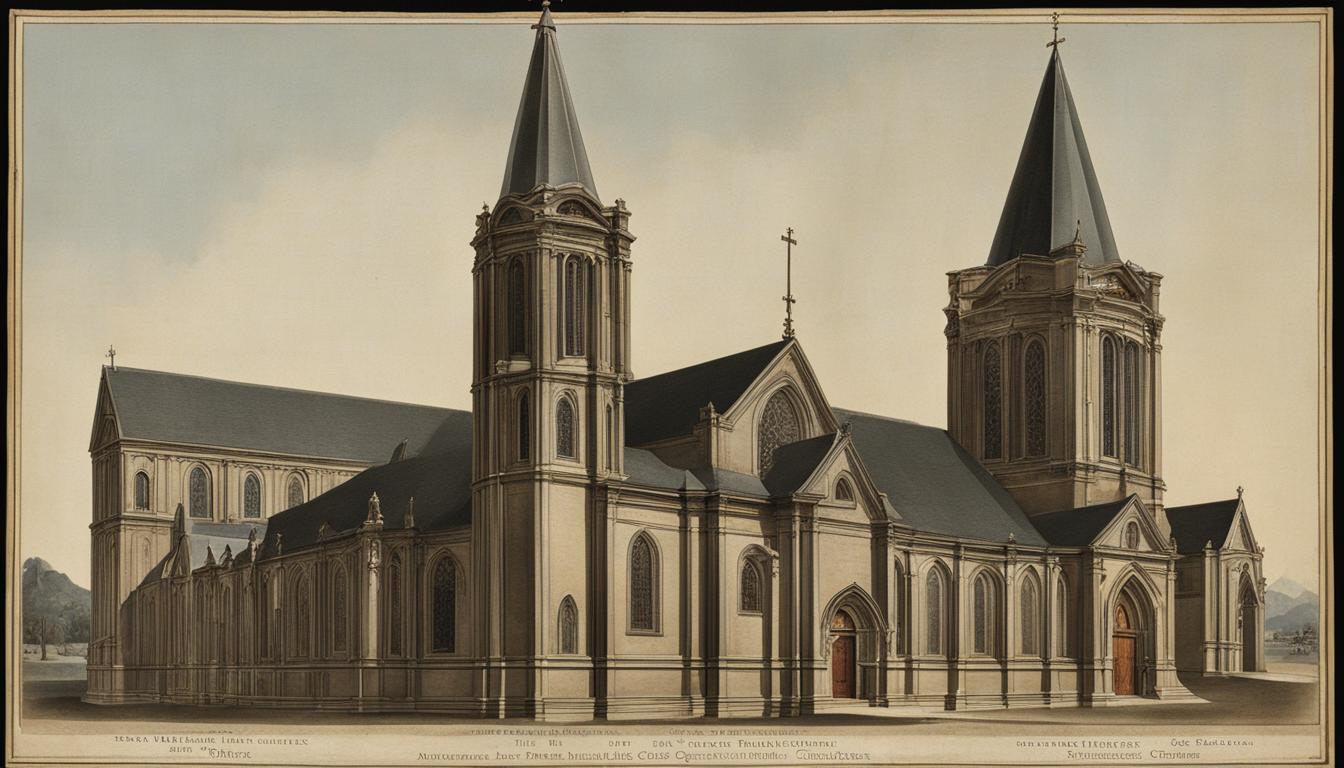The Pentecostal Church is a vibrant and diverse Christian denomination with a rich history. It traces its origins to the early 20th century, particularly the Azusa Street Revival in Los Angeles in 1906. This revival, led by William J. Seymour, marked the beginning of the modern Pentecostal movement. From there, Pentecostalism spread rapidly throughout the United States and eventually across the globe, becoming one of the fastest-growing Christian movements in the world.
The founders of the Pentecostal Church, such as William J. Seymour and Charles F. Parham, played pivotal roles in its early development. They emphasized the baptism of the Holy Spirit and speaking in tongues, which became defining characteristics of Pentecostalism. The movement’s key beliefs include the belief in the baptism of the Holy Spirit, divine healing, and the imminent return of Jesus Christ. Pentecostal worship practices are characterized by their energetic and expressive nature, designed to create an atmosphere conducive to experiencing the presence and power of the Holy Spirit.
The historical significance of the Pentecostal Church cannot be understated. Its emphasis on personal spiritual experiences and the power of the Holy Spirit challenged traditional religious practices and led to a revival of faith in many communities. The growth of Pentecostalism has also contributed to the rise of charismatic movements within other Christian denominations.
Throughout its history, the Pentecostal movement has experienced various denominational splits and schisms. These divisions were often the result of theological disagreements or differences in worship styles. Today, there are numerous Pentecostal denominations, each with its distinct practices and beliefs.
The Pentecostal Church is typically organized in a hierarchical structure with various levels of leadership. Pastors and spiritual leaders play essential roles in guiding the local congregations. Pentecostal churches also actively engage in community outreach programs and social justice issues, making a positive impact on their local communities.
It is estimated that there are between 250 million to 500 million Pentecostal Christians globally, making it one of the largest Christian denominations. This represents a significant percentage of the overall world’s population of Christians.
Key Takeaways:
- The Pentecostal Church traces its origins to the early 20th century and the Azusa Street Revival led by William J. Seymour.
- Pentecostalism is characterized by its emphasis on personal spiritual experiences, the baptism of the Holy Spirit, and speaking in tongues.
- The movement’s historical significance includes challenging traditional religious practices and contributing to the rise of charismatic movements.
- Pentecostal churches have experienced various denominational splits, resulting in diverse practices and beliefs.
- Pastors and spiritual leaders play crucial roles in the hierarchical structure and governance of Pentecostal churches.
- Pentecostal worship practices are energetic and expressive, designed to create an atmosphere where believers can experience the presence and power of the Holy Spirit.
- The Pentecostal Church continues to have a significant influence in contemporary society through its emphasis on personal spiritual experiences, holistic healing, and social engagement.
- There are estimated to be between 250 million to 500 million Pentecostal Christians worldwide, representing a significant portion of the global Christian population.
Founders of the Pentecostal Church
The early development of the Pentecostal movement can be attributed to influential leaders who played vital roles in its formation. One of the most noteworthy figures is William J. Seymour, who emerged as a key leader during the Azusa Street Revival in Los Angeles in 1906. Seymour’s emphasis on the baptism of the Holy Spirit and speaking in tongues became defining characteristics of Pentecostalism. His teachings and leadership became instrumental in the rapid spread of the movement.
Another significant founder of the Pentecostal Church is Charles F. Parham. Parham established a Bible school in Topeka, Kansas, in 1901, where he laid the foundations for Pentecostalism. It was at this school that the doctrine of speaking in tongues was first proclaimed. Parham’s teachings and the subsequent outpouring of the Holy Spirit at the school became a catalyst for the Pentecostal revival.
Aimee Semple McPherson, a prominent female evangelist, also played a crucial role in the early growth of Pentecostalism. McPherson’s dynamic preaching and emphasis on spiritual experiences helped popularize the movement in the early 20th century. Her evangelistic campaigns and healing services attracted large crowds, fueling the expansion of Pentecostalism.
“The early founders of the Pentecostal Church, such as Seymour, Parham, and McPherson, laid the groundwork for a movement that would have a profound impact on Christianity worldwide.”
Pivotal Figures in the Early Pentecostal Movement:
| Founder | Contributions |
|---|---|
| William J. Seymour | Leadership during the Azusa Street Revival, emphasis on the baptism of the Holy Spirit and speaking in tongues |
| Charles F. Parham | Establishment of the Bible school in Topeka, Kansas, first proclamation of the doctrine of speaking in tongues |
| Aimee Semple McPherson | Promotion of Pentecostalism through evangelistic campaigns and healing services |
The contributions of these early founders, along with many others, laid the groundwork for a movement that would have a profound impact on Christianity worldwide. Their teachings and emphasis on the power of the Holy Spirit continue to shape the beliefs and practices of Pentecostal churches today.
Key Beliefs and Doctrines of the Pentecostal Church
The Pentecostal Church is defined by its unique set of beliefs and doctrines that set it apart from other Christian denominations. Central to Pentecostalism is the belief in the baptism of the Holy Spirit, which is understood as a separate experience from salvation and is often accompanied by speaking in tongues. This baptism is seen as empowering believers with spiritual gifts, such as prophecy, healing, and the ability to discern spirits.
Another key belief in the Pentecostal Church is the emphasis on divine healing. Pentecostals believe that God has the power to heal physical and emotional ailments through prayer, laying on of hands, and anointing with oil. This belief in divine healing is rooted in the biblical teachings of Jesus’ ministry and is seen as a sign of God’s continued presence and power in the world today.
Additionally, Pentecostals hold a strong belief in the imminent return of Jesus Christ. They believe that Jesus will return to earth to establish His kingdom and judge the living and the dead. This belief in the second coming of Christ influences their understanding of the present age and shapes their eschatological worldview.
“The Pentecostal Church places a high value on personal spiritual experiences and the power of the Holy Spirit. Speaking in tongues, divine healing, and the imminent return of Jesus Christ are central to the Pentecostal doctrine.”
The table below summarizes the key beliefs and doctrines of the Pentecostal Church:
| Beliefs and Doctrines | Description |
|---|---|
| Baptism of the Holy Spirit | Believing in a separate experience from salvation, often accompanied by speaking in tongues and empowering believers with spiritual gifts. |
| Divine Healing | Believing in the power of God to heal physical and emotional ailments through prayer, laying on of hands, and anointing with oil. |
| Imminent Return of Jesus Christ | Believing in the imminent return of Jesus to establish His kingdom and judge the living and the dead. |
| Personal Spiritual Experiences | Placing a high value on personal encounters with God, such as speaking in tongues, prophetic utterances, and other manifestations of the Holy Spirit. |
These beliefs and doctrines form the foundation of Pentecostalism and shape the way Pentecostal Christians understand and practice their faith. The emphasis on personal spiritual experiences and the power of the Holy Spirit sets the Pentecostal Church apart as a vibrant and dynamic movement within Christianity.
Historical Significance of the Pentecostal Church
The Pentecostal movement has had a profound historical significance, both within Christianity and in the wider religious landscape. Originating from the Azusa Street Revival in 1906, it marked the beginning of a vibrant spiritual awakening that challenged traditional religious practices and led to a renewed sense of faith. The Pentecostal revival, characterized by its emphasis on personal spiritual experiences and the power of the Holy Spirit, spread rapidly throughout the United States and eventually across the globe.
This movement played a pivotal role in revitalizing Christianity by bringing the transformative power of the Holy Spirit to the forefront. It challenged the formalism and ritualism that had become prevalent in many Christian denominations at the time, encouraging believers to seek a deeper, more experiential relationship with God. The emphasis on spiritual gifts, such as speaking in tongues and divine healing, brought a renewed sense of fervor and expectancy in the believers’ lives.
The historical significance of the Pentecostal Church extends beyond its impact on individual believers. It also sparked a charismatic renewal within other Christian denominations, leading to the rise of charismatic movements that emphasized the ongoing work of the Holy Spirit in the lives of believers. Today, charismatic Christianity has become a significant and influential force within the wider Christian community, with millions of believers around the world identifying as Pentecostal or charismatic.
| Key Points of Historical Significance | Impact |
|---|---|
| Revitalized Christianity | Challenged traditional religious practices and brought a renewed sense of faith |
| Emphasis on Personal Spiritual Experiences | Encouraged believers to seek a deeper, more experiential relationship with God |
| Charismatic Renewal | Spark a charismatic movement within other Christian denominations |
| Global Influence | Millions of believers worldwide identify as Pentecostal or charismatic |
Pentecostal Denominations: Exploring the Diverse Landscape of the Pentecostal Church
As the Pentecostal movement grew and spread throughout the world, it inevitably gave rise to various denominational splits and schisms. These divisions often stemmed from theological differences or disagreements on worship practices. Today, the Pentecostal Church is comprised of numerous denominations, each with its own unique set of beliefs and practices. Let’s take a closer look at some of the prominent denominations within the Pentecostal movement.
Assemblies of God
The Assemblies of God is one of the largest Pentecostal denominations in the world. It was founded in the early 20th century and has since grown to include millions of members in over 200 countries. The Assemblies of God places a strong emphasis on the baptism of the Holy Spirit, divine healing, and evangelism. They believe in the authority of the Bible and encourage personal spiritual experiences and the use of spiritual gifts.
Church of God in Christ
The Church of God in Christ (COGIC) is another major Pentecostal denomination, primarily serving African-American believers. It was founded in the early 1900s and has a rich history of influential leaders such as Bishop Charles Harrison Mason. The COGIC places particular importance on holiness and sanctification, as well as the empowerment of the Holy Spirit. They also prioritize community outreach and social justice initiatives.
International Pentecostal Holiness Church
The International Pentecostal Holiness Church (IPHC) is a global Pentecostal denomination with roots in the Holiness movement. It was founded in the early 20th century and has a strong presence in the United States, as well as in other countries around the world. The IPHC places a strong emphasis on holiness, personal spiritual growth, and evangelism. They believe in the gifts of the Holy Spirit and the power of prayer.
These are just a few examples of the many Pentecostal denominations that exist today. Each one has its own unique history, traditions, and beliefs, but they all share a common foundation in the Pentecostal movement. The diversity within the Pentecostal Church is a testament to the dynamic nature of this Christian denomination and its ability to adapt and grow in different cultural and geographical contexts.
Leadership and Governance in the Pentecostal Church
The Pentecostal Church, with its diverse denominations and global reach, follows a hierarchical structure with various levels of leadership. Each denomination within the Pentecostal movement has its own governing bodies responsible for overseeing the spiritual and administrative affairs of the church. These governing bodies may consist of bishops, overseers, or general superintendents, who provide guidance, support, and direction to the local congregations.
Pentecostal churches place a strong emphasis on spiritual authority and leadership, viewing pastors as key figures in the community. Pastors are seen as spiritual shepherds, responsible for guiding and nurturing the members of their congregations. They play a central role in preaching, teaching, and providing pastoral care, helping individuals grow in their faith and relationship with God.
Additionally, Pentecostal churches often have auxiliary leadership teams composed of elders, deacons, and other appointed or elected individuals who assist in various roles within the church. These teams work together to support the pastor and ensure the smooth functioning of the church’s ministries and activities.
The Role of Women in Pentecostal Leadership
One distinctive aspect of the Pentecostal Church is its recognition and inclusion of women in leadership roles. Unlike some other Christian denominations, Pentecostalism has paved the way for women to serve in positions of authority and influence. Many Pentecostal churches have women pastors, bishops, and evangelists, breaking traditional gender barriers and providing opportunities for women to exercise their spiritual gifts and talents.
| Denomination | Leadership Structure |
|---|---|
| Assemblies of God | General Superintendent, District Superintendents, Local Pastors |
| Church of God in Christ | Presiding Bishop, Jurisdictional Bishops, Local Pastors |
| International Pentecostal Holiness Church | General Superintendent, District Superintendents, Local Pastors |
It is important to note that while women hold leadership positions in many Pentecostal churches, the level of acceptance and inclusion may vary among denominations and individual congregations. Some denominations may have more conservative views regarding women in leadership, while others embrace and encourage their involvement.
The leadership and governance structure of the Pentecostal Church ensures that there is a clear framework for decision-making, spiritual guidance, and accountability. It supports the growth and development of local congregations, enabling them to fulfill their mission of spreading the message of the Gospel and impacting their communities positively.

“In the Pentecostal Church, leadership is not about control or dominance but about servant-heartedness and empowering others to fulfill their God-given purpose.” – Pastor Sarah Johnson
Worship Practices in the Pentecostal Church
Worship in the Pentecostal Church is a dynamic and vibrant expression of faith, rooted in the belief in the power of the Holy Spirit. Pentecostal worship services are characterized by an atmosphere of enthusiastic praise and heartfelt devotion. The aim is to create an environment where believers can connect with God on a deeply personal level and experience His presence in a tangible way.
“In the Pentecostal Church, worship is not just a ritual or an obligation. It is an opportunity to express our love for God and encounter Him in a transformative way,” says Reverend Sarah Johnson, a Pentecostal pastor with over 20 years of experience.
Music plays a central role in Pentecostal worship, with lively and energetic singing considered a vital part of the service. The songs often feature lyrics that exalt God’s power, love, and saving grace. Congregational participation is encouraged, and it is not uncommon to see people clapping, dancing, and raising their hands in worship. Instrumental accompaniment, including guitars, drums, and keyboards, adds to the lively and celebratory atmosphere.
The practice of speaking in tongues is another significant aspect of Pentecostal worship. This spiritual gift, believed to be the supernatural ability to speak in languages unknown to the speaker, is viewed as a direct communication between the individual believer and God. It is often accompanied by interpretation, which allows the congregation to understand the message conveyed.
| Worship Practices | Explanation |
|---|---|
| Singing and Music | Lively and energetic singing, accompanied by musical instruments, is a central part of Pentecostal worship. |
| Clapping, Dancing, and Raising Hands | Physical expressions of worship, such as clapping, dancing, and raising hands, are encouraged as ways to honor and connect with God. |
| Speaking in Tongues | Believers may speak in tongues as a form of spiritual communication with God. |
| Prophetic Utterances | Prophetic messages and words of encouragement or exhortation may be shared during the worship service. |
“Pentecostal worship is a powerful and transformative experience,” adds Reverend Johnson. “It is a time when we can fully express our love and devotion to God, as well as receive guidance and encouragement through the spiritual gifts imparted by the Holy Spirit.”
Overall, worship in the Pentecostal Church is an integral part of the faith journey, providing believers with an opportunity to connect with God, experience His presence, and be empowered by the Holy Spirit.
Contemporary Influence of the Pentecostal Church
The Pentecostal Church has had a profound impact on contemporary society, leaving an indelible mark on both religious and social spheres. Its emphasis on personal spiritual experiences and holistic healing resonates with individuals seeking a more experiential form of Christianity. Pentecostalism’s focus on the power of the Holy Spirit has sparked a renewed interest in spiritual practices, leading to a revival of faith and a deeper connection to God.
One of the notable ways in which the contemporary Pentecostal Church influences society is through its strong commitment to community outreach and social justice. Pentecostal churches are known for their active involvement in addressing societal issues such as poverty, inequality, and injustice. They organize various programs and initiatives to provide assistance to those in need, ranging from food drives and homeless shelters to advocacy and awareness campaigns.
The impact of the Pentecostal Church extends beyond its religious practices and social engagement. As one of the largest Christian denominations globally, Pentecostalism has shaped the cultural fabric of many regions. Its vibrant worship style, characterized by energetic singing, clapping, and dancing, has influenced contemporary Christian music and worship practices. The Pentecostal movement’s emphasis on speaking in tongues and prophetic utterances has also had a significant impact on the charismatic and spiritual renewal movements within other Christian denominations.
| Pentecostal Church | Contemporary Influence | |
|---|---|---|
| Beliefs | Emphasis on personal spiritual experiences and the power of the Holy Spirit | Inspires individuals seeking experiential spirituality |
| Social Engagement | Active involvement in community outreach and social justice | Addresses societal issues and makes a positive impact on local communities |
| Cultural Influence | Vibrant worship style and emphasis on speaking in tongues | Shapes contemporary Christian music and worship practices |
“The Pentecostal Church’s influence goes beyond the walls of its congregations. Its commitment to social justice and its vibrant worship practices have shaped the broader cultural landscape, inspiring individuals and impacting communities.” – Rev. Sarah Thompson
Personal Transformation and Empowerment
One of the key ways in which the Pentecostal Church influences individuals is through personal transformation and empowerment. The emphasis on the baptism of the Holy Spirit and the belief in spiritual gifts empowers believers to experience a deeper connection with God and discover their unique spiritual abilities. This personal transformation often leads to a renewed sense of purpose and a desire to make a positive impact on the world.
Moreover, Pentecostalism’s focus on divine healing and miracles provides hope and comfort to those facing physical, emotional, or spiritual challenges. The belief in God’s power to heal and restore brings solace and inspires faith in the midst of difficult circumstances. Many individuals have testified to the transformative power of Pentecostal spirituality in their lives, attesting to the life-changing influence of the Pentecostal Church.
The Global Reach of Pentecostalism
The contemporary influence of the Pentecostal Church is evident in its global reach. With an estimated worldwide membership ranging from 250 million to 500 million, Pentecostalism is one of the largest and fastest-growing Christian movements. Its impact can be felt in every continent, with vibrant Pentecostal communities thriving in diverse cultural, linguistic, and socio-economic contexts.
From the bustling mega-churches in the United States to the grassroots gatherings in remote villages, the Pentecostal Church continues to attract followers from all walks of life. Its message of hope, spiritual empowerment, and social engagement resonates with people seeking a deeper experience of faith and a way to actively contribute to societal change.

Current World Membership and Percentage of World Religions
The Pentecostal Church has experienced tremendous growth and has a significant global presence. While exact membership numbers are challenging to determine due to the diverse nature of the movement, it is estimated that there are between 250 million to 500 million Pentecostal Christians worldwide. This makes Pentecostalism one of the largest Christian denominations in the world.
The Pentecostal movement’s expansive reach is reflected in its widespread influence across different regions and cultures. Pentecostal churches can be found in nearly every country, with particularly large congregations in countries such as Brazil, Nigeria, the Philippines, and the United States.
In terms of the percentage of world religions, Pentecostalism represents a significant portion of the global Christian population. While precise figures vary depending on different sources, estimates suggest that Pentecostalism makes up around 25% of the world’s Christian community.
| World Religion | Percentage of Population |
|---|---|
| Christianity | 31.2% |
| Pentecostalism | ~25% of Christians |
| Islam | 24.1% |
| Hinduism | 15.1% |
| Buddhism | 6.9% |
| Judaism | 0.2% |
These statistics highlight the significant impact and influence of the Pentecostal Church within the global religious landscape. With its emphasis on personal spiritual experiences, vibrant worship practices, and community involvement, Pentecostalism continues to attract believers and shape the lives of millions around the world.
Conclusion
The history of the Pentecostal Church is a fascinating journey that traces its origins to the early 20th century. Starting with the Azusa Street Revival led by William J. Seymour, the movement quickly spread throughout the United States and beyond, becoming one of the fastest-growing Christian movements in the world.
Key figures such as Seymour, Charles F. Parham, and Aimee Semple McPherson played crucial roles in shaping the early development of Pentecostalism. Their emphasis on the baptism of the Holy Spirit, speaking in tongues, and personal spiritual experiences became defining characteristics of the movement.
Pentecostalism’s focus on the gifts of the Holy Spirit, divine healing, and the imminent return of Jesus Christ sets it apart from other Christian denominations. Its impact on the religious landscape has been profound, leading to a revival of faith in many communities and contributing to the rise of charismatic movements across various denominations.
Throughout its history, the Pentecostal movement has experienced denominational splits and schisms, often due to theological disagreements and worship style differences. Today, there are numerous Pentecostal denominations, each with its distinct practices and beliefs.
The Pentecostal Church’s hierarchical structure places importance on strong leadership and governance, with pastors playing a central role in guiding local congregations. The worship practices of the Pentecostal Church are characterized by their energetic and expressive nature, aimed at creating an atmosphere conducive to experiencing the presence and power of the Holy Spirit.
The contemporary influence of the Pentecostal Church is significant, with its emphasis on personal spiritual experiences and holistic healing resonating with many individuals seeking a more experiential form of Christianity. Pentecostal churches are known for their community outreach programs and involvement in social justice issues, making a positive impact on their local communities.
While accurate data on the exact number of Pentecostal believers worldwide is challenging to determine, estimates suggest that there are between 250 million to 500 million Pentecostal Christians globally, making it one of the largest Christian denominations and a substantial percentage of the overall world’s population of Christians.
In conclusion, the Pentecostal Church’s rich history, diverse origins, and enduring legacy make it a significant force within Christianity. Its emphasis on the power of the Holy Spirit and personal spiritual experiences continues to shape the lives of millions of believers around the world.
FAQ
What is the history of the Pentecostal Church?
The Pentecostal Church traces its origins to the early 20th century, particularly the Azusa Street Revival in Los Angeles in 1906. This revival marked the beginning of the modern Pentecostal movement, which spread rapidly throughout the United States and eventually across the globe.
Who were the founders of the Pentecostal Church?
The Pentecostal movement owes much of its early development to influential leaders such as William J. Seymour, who played a pivotal role in the Azusa Street Revival. Other notable figures include Charles F. Parham and Aimee Semple McPherson.
What are the key beliefs and doctrines of the Pentecostal Church?
Pentecostalism is characterized by its emphasis on the gifts of the Holy Spirit and personal spiritual experiences. Key beliefs include the baptism of the Holy Spirit, speaking in tongues, divine healing, and the imminent return of Jesus Christ.
What is the historical significance of the Pentecostal Church?
The Pentecostal movement challenged traditional religious practices and led to a revival of faith in many communities. It also contributed to the rise of charismatic movements within other Christian denominations.
Have there been any denominational splits or schisms in the Pentecostal Church?
Yes, throughout its history, the Pentecostal movement has experienced various denominational splits and schisms, often resulting from theological disagreements or differences in worship styles.
How is leadership and governance structured in the Pentecostal Church?
The Pentecostal Church is typically organized in a hierarchical structure with various levels of leadership. Each denomination may have its own governing bodies, such as bishops, overseers, or general superintendents.
What are the worship practices in the Pentecostal Church?
Worship in the Pentecostal Church is characterized by its energetic and expressive nature. It often includes singing, clapping, dancing, raising hands in praise, speaking in tongues, and prophetic utterances.
What is the contemporary influence of the Pentecostal Church?
The Pentecostal Church continues to have a significant influence in contemporary society, resonating with individuals seeking a more experiential form of Christianity. It is known for its community outreach programs and involvement in social justice issues.
How many members does the Pentecostal Church have worldwide?
Accurate data on the exact number of Pentecostal believers worldwide is difficult to determine, but estimates range from 250 million to 500 million, making it one of the largest Christian denominations.
What is the conclusion of the rich history of the Pentecostal Church?
The history of the Pentecostal Church is a story of passionate faith, spiritual renewal, and global impact. From its humble beginnings, it has grown into a diverse and influential force within Christianity, shaping the lives of millions of believers worldwide.
















